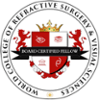Strabismus, more commonly referred to as a squint, is a medical condition where the eyes point in two different directions. This happens when the opposite eye is looking forward. This can result in blurred vision, a lazy eye, or double vision. Since most squints occur or develop during childhood, it is ideal to treat them before they fully develop. This is typically through the use of glasses at a younger age since many squints are caused by the eyes compensating for some other visual impairment….
Tag: Lazy Eye
Can I Have Laser Eye Surgery If I Have Prism? [VIDEO]
Patients who have strabismus may have a prism inserted into their glasses to help correct eye alignment, along with the refractive error. Laser eye surgery is able to deal with the refractive error but cannot affect eye alignment. …
Can Laser Eye Surgery Treat Amblyopia (Lazy Eye)? [VIDEO]
What is Amblyopia (Lazy Eye) – and can Laser Eye Surgery help? Amblyopia – more commonly known as ‘lazy eye’ – is a disorder in which vision in one eye is not fully developed. It can co-occur with refractive errors such as short-sightedness, long-sightedness, and astigmatism. If you have amblyopia and have been considering refractive treatment to correct your prescription, you may wonder: Can Laser Eye Surgery help? Amblyopia is estimated to affect around between 1% and 5% of the…
Can Cataract Surgery Correct a “Lazy Eye”?
Can Cataract Surgery Correct a “Lazy Eye”? The primary aim of Cataract Surgery is to remove cataracts from the eye and address cataract-related vision loss. But that doesn’t necessarily mean that the procedure can’t help with other problems. For example, private Cataract Surgery can address refractive errors in addition to vision impairment caused by the cataract itself. So, what about other types of eye-related issues? In this article, we’re taking a look at “lazy eye” (also known as amblyopia) and…


